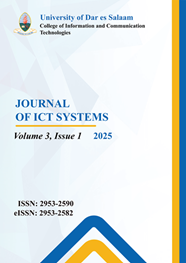Evaluation of the Effectiveness and Awareness of Mobile Money Services among Users in Tanzania A Case of Iris Biometric Authentication Method
Main Article Content
Abstract
This study evaluates user perceptions of a framework proposed by Rashidi et al. [11] that uniquely combines iris biometric authentication (IRBAM) with two-factor authentication (2FA), incorporating liveness detection to enhance security in mobile money services (MMSs) in Tanzania. The IRBAM-2FA combination is novel for Tanzania’s MMS, leveraging unique iris patterns and liveness detection to enhance security over prevalent PIN-based systems vulnerable to fraud. Through a survey-based evaluation of a demo application, involving 258 respondents (204 customers, 54 agents) in Dodoma, we assessed the framework’s effectiveness in preventing unauthorized access, its convenience, and user acceptance. Findings show that 79.41% of customers are aged 18–35, suggesting a tech-savvy audience likely to embrace IRBAM-2FA, as younger individuals are typically more open to innovative technologies. Additionally, 46.1% of customers and 51.9% of agents strongly agreed that the framework enhances security, while 85.5% of customers and 71.6% of agents expressed willingness to adopt it. Low IRBAM awareness (65.2% of customers, 79.9% of agents), usability issues (20% of agents' disagreement), cost (30%), and health risks (40%), pose barriers, with future work needed on feature phone support and rural testing for inclusivity. These insights underscore the potential of IRBAM to foster trust in MMS.
Article Details

This work is licensed under a Creative Commons Attribution-NonCommercial-NoDerivatives 4.0 International License.

